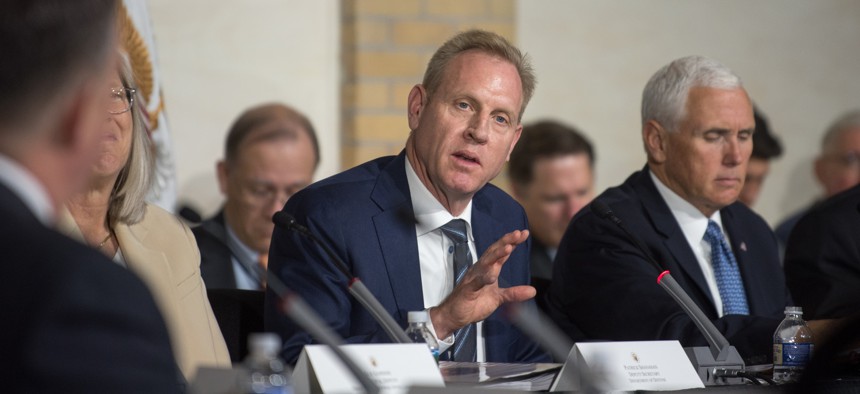
Deputy Defense Secretary Patrick Shanahan speaking at an Oct. 23 meeting of the National Space Council. U.S. Army Sgt. Amber I. Smith
Pentagon Officials Debating How Fast to Launch Space Force, Deputy Says
White House panel announces formal recommendations, while Deputy Defense Secretary Patrick Shanahan confirms NRO will remain apart from Space Force.
Pentagon officials drawing up the blueprints for its future Space Force are debating which of the Defense Department’s space-related missions to transfer immediately into the new sixth branch of the military.
“The Space Force will get built out over time,” said Deputy Defense Secretary Patrick Shanahan on Tuesday after a National Space Council meeting in Washington featuring Vice President Mike Pence. Shanahan, the Pentagon’s No. 2 ranking civilian, is leading the Defense Department’s team that is crafting a Space Force legislative proposal for Congress’ approval.
“Even if you said, ‘Tonight we’re going to change everything,’ it’s a little bit impractical to try...to spin that many plates [at once],” he said.
The Air Force and the other military service branches all have various space-related missions or interests, and opinions about which of them should be shifted into the new Space Force. Shanahan acknowledged the department has not settled on a timeline for bringing all of these organizations under one umbrella. “The piece…that there’s not common…agreement on is how fast does the Space Force evolve?”
An early draft of the Defense Department’s Space Force proposal, first reported by Defense One on Monday, revealed some of Shanahan’s early recommendations. On Tuesday, the deputy secretary confirmed one of those details — that the National Reconnaissance Office, or NRO, is not expected to be part of the Pentagon’s initial Space Force blueprints For now, Pentagon officials are focusing ways the spy agency and Space Force will “integrate technically” instead of absorbing the intelligence organization into the new service, Shanahan said.
Related: Here’s The Pentagon’s Initial Plan For Creating a Space Force
Related: Air Force Pushes Back on Pentagon’s First Blueprints for Trump’s Space Force
Related: What Trump’s Space Force Announcement Means
Related: USAF’s Space Force Cost-Estimate Is Likely Too High: Analyst
Related: Mattis Asks Trump to OK US Space Command, Pick Leaders
Earlier this month, Defense Secretary Jim Mattis sent a memo to the White House asking for official presidential direction to create U.S. Space Command, a new warfighting combatant command. On Tuesday, the White House announced that the National Space Council — a group of political appointees and military officials — had approved six recommendations including the creation of the Space Force, forming U.S. Space Command and starting a Space Development Agency to oversee buying new satellites.
“We have real steps we’re taking to put together the Space Force,” Shanahan, who sat next to Pence, the Space Council chairman, during Tuesday’s meeting at National Defense University. “We’re very mindful of not creating more cost.”
Shanahan said the recommendations “are very focused on things that are tangible to grade. They’re real work products, they’re not aspirational.”




